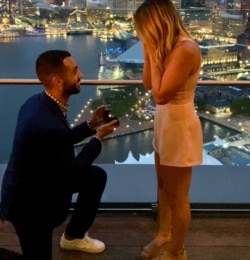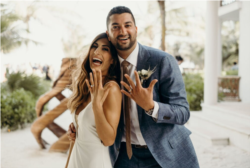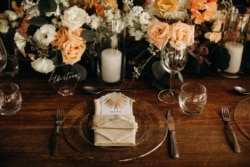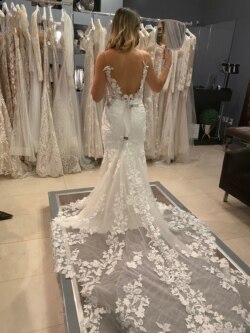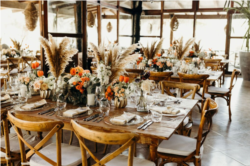Ameera Ahmadieh is getting married in October. And while planning a wedding during a pandemic is not easy, she is excited about getting all her favorite people together to celebrate.
The Maryland-based product testing analyst says she always dreamed of finding the right person rather than her actual wedding day, but she quickly got caught up in what some experts call the “wedding industrial complex.”
“The venue I chose actually takes care of the rentals for tables, chairs, linens and catering,” she says. “We'll still need the florist, photographer, videographer — if we decide to do the videographer — and DJ. And then, now I'm remembering all the little details, the signs on the table, napkins, you know, any extra touches you want for the day. So, the list seems like it never ends.”
The expectation of a showcase wedding featuring a traditional white dress with all the expensive trimmings gained ground after World War II, prompted in part by the availability of new inexpensive fabrics like nylon and rayon — developed during the war to make parachutes — that could be used to make wedding gowns at a far lower cost than satin and silk.
And diamonds did not become a bride’s best friend until the 1930s. Diamond rings were not associated with marriage proposals until an advertising drive from the De Beers diamond cartel in the late 1940s embedded the idea in American culture.
“They found a small association between diamonds and love, and they hired a Madison Avenue advertising company that came up with this idea of ‘diamonds are forever,’” says Laurie Essig, a professor and director of gender, sexuality and feminist studies at Middlebury College and the author of “Love, Inc.”
“They even paid Hollywood to put diamond rings in various movies,” Essig says.
The massive wedding industry is made up of event planners, dressmakers, jewelers, florists, caterers, venues, DJs, photographers, videographers, hair stylists and makeup artists who all depend on weddings to make a living.
“It has become big business in the U.S. since World War II. Weddings have become a real engine of the American economy when you think about all of the different businesses that are involved,” says Katherine Jellison, a professor of history at Ohio University and author of “It's Our Day: America's Love Affair with the White Wedding, 1945-2005.”
“It's all this stuff that is made up by industries that need to sell us something, and the way they sell it to us is through the promise of happily ever after,” says Essig.
Before brides and grooms buy into spending tens of thousands of dollars on wedding-related goods and services, the culture sells them on the idea that it must be worth it.
“You can see a million ways in which the toys that are sold to little girls,” Jellison says, “the animated films that they’re urged to go see, do play up this kind of fairy tale princess image that maybe the only time a young woman has an opportunity to play that in real life is when she dons a floor-length white gown on her wedding day.”
A woman’s wedding day is the one time she can be the center of attention without any lingering feelings of guilt, according to Jellison, who personally ranks the day she defended her doctoral dissertation above her wedding as one of the best days of her life.
“But society has not coalesced around some of these other occasions that individual women might say are more important days to be celebrated,” she says. “But society has accepted the idea that on a woman's wedding day, this is a day that she deserves to be the center of attention, that everyone should see her as the star of the show.”
As part of her research, Essig interviewed couples at wedding expos, where wedding vendors try to sell their goods and services to future brides and grooms. She found that the young couples are seeking security in the future during uncertain social and economic times.
“From 1980 forward, you start seeing increased spending on weddings and an increased growth in both the wedding industry, but also romance ideology. Princess movies come back. Disney doesn't even make princess movies for a while there in the 70s and 80s,” Essig says. “So, I think what we're seeing is we, as a country, turned to this idea that the only way I can have a safe and secure future is if I find ‘the one’ and we ride off into the sunset.”
And while future bride Ahmadieh never had grandiose expectations for her own wedding, one of her biggest stressors is what her guests will think of her big day.
“The expectation of people, or what people expect for your wedding, I think that adds a little bit of pressure, because people are taking the time, spending money to go to your wedding, so you want to make sure that your wedding is meeting their expectations,” she says. “And then, on top of that, you have people's opinions a lot. So, it's kind of hard to stay focused and plan without letting expectations take over.”
COVID-19 restrictions have forced many couples to downscale their weddings, but Jellison does not expect more modest celebrations to become a trend once the pandemic ends. If people can afford to go big, she thinks they will.
“If history is any guide, weddings will be back and bigger than ever after the pandemic. That's what happened after World War II,” Jellison said in an email following her interview with VOA. “After all those years of first, the Great Depression, and then the war, people were in the mood to celebrate and spend. I think the same thing may happen post-pandemic. After a couple of years of scaled-back consumer spending on big celebrations, all that pent-up energy and disposable income will have to go somewhere.”





